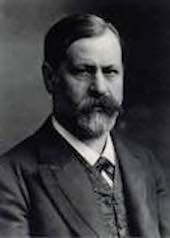Sigmund Freud
1856-1939

Sigmund Freud was born in the 1856 in the Austrian Empire. He graduated from the University of Vienna medical school in 1881. A few years later, in 1886, he set up a therapy practice in his home in Vienna.
Sigmund Freud was best known for his creation of a psychoanalytic theory involving the influences of the unconscious mind. He saw the mind as a complex energy-system, consisting of an ego, id, and superego, all psychological constructs. He articulated and refined the concepts of the unconscious and of the role, throughout life of infantile sexuality and repression. He also proposed a “talking cure” to remediate psychological disorders.
Freud also theorized about speech disorders, especially aphasia and stuttering. In 1881, just after graduating from medical school, he hypothesized about brain localization in second language learning and aphasia. He argued against the strict localization theories of Paul Broca and Karl Wernicke. Later, Freud wrote about the causes of stuttering, attributing its origins to psychological rather than biological problems.
In 1938, Freud and some of his family left Austria to escape Nazi persecution. He died in exile in London in 1939.
Freud on aphasia:
In 1891, at the beginning of his career, before he invented psychoanalysis, Freud published a book on aphasia. In it he argued against the the localization theorists who argued that specific areas of the brain served specific psychological functions. Taking issue with Broca and Wernicke, his contemporaries, who argued for separate language areas in the brain, one underlying motor aphasia and another sensory aphasia, Freud contended that there was but one area of the brain that was involved in the processing of language. Also, Freud supported a functional conception of brain activity over a structural one.
Freud and his followers on stuttering:
Freud felt the adult stutterer's speech mechanism was enmeshed in a conflict between the wish to defecate symbolically on his parents and authority figures by using hostile words and a concurrent fear of retaliation that caused the stutterer to hold the fecal-oriented words inside.
The early psychiatric theories about stuttering (1900-1945) generally were written in support of Freud's anal displacement theory, and led to the recommendation that stutterers undergo psychotherapy or psychoanalysis.
Modifications to Freud's theory about stuttering were made by psychoanalytical theorists after 1945. For example psychiatrists Kolansky (1960, 1967) and Glauber (1983) have both implicated the parent in the etiology of stuttering. In 1960, Kolansky wrote about his treatment and cure of a 3-year-old girl who began stuttering when her mother gave birth to twins and her grandmother concurrently vigorously bowel-trained her. In 1967, he advocated the idea that a child's stuttering treatment should include the parents' active participation.
More recent applications of Freudian constructs in speech pathology have been to attribute the cause of stuttering to a “conversion disorder” (Mahr & Leith, 1992). Freud coined the term “conversion” to describe the effect of a traumatic psychological event disrupting a drive or energy. The energy, instead, is converted into a physical symptom, such as stuttering, that symbolizes an unconscious mental conflict. Freud originally hypothesized that stuttering represented a converted reaction to a childhood trauma (Ratner, 2014).
References on how Freud’s theories have impacted the field of speech pathology, arranged chronologically
Freud, S. (1891) On aphasia. Retrieved from: https://www.sigmundfreud.net/on-aphasia-pdf-ebook.jsp
Kolansky, H. (1960).Treatment of a three-year old girl's severe infantile neurosis: Stammering and insect phobia. Psychoanalytic Study of the Child 15, 261–285.
Kolansky H. (1967). Some psychoanalytic considerations on speech in normal development and psychopathology. Psychoanalytic Study of the Child, 22, 274–295.
Marx, O. (1967) Freud and aphasia: An historical analysis. American Journal of Psychiatry, 124(6):815-25. doi: 10.1176/ajp.124.6.815.
Glauber, P. (1983) Stuttering: A psychoanalytic understanding. Human Sciences Press.
Miller L. (1991). On aphasia at 100: The neuropsychodynamic legacy of Sigmund Freud. Psychoanalytic Review, 78, 3, 365-378.
Mahr, G. & Leith, W. (1992). Psychogenic stuttering of adult onset. Journal of Speech and Hearing Research, 35, 2, 283-86.
Wallesch, C. & Bartels, C. (1996). Freud’s impact on aphasiology--aphasiology's impact on Freud. Journal of the History of Neuroscience. 5, 2, 117-125. doi: 10.1080/09647049609525659.
Ratner, N. (2014) Nan Bernstein Ratner on Freud’s theory that stuttering as a conversion disorder. The Stuttering Foundation. https://www.stutteringhelp.org/stress-stuttering.
